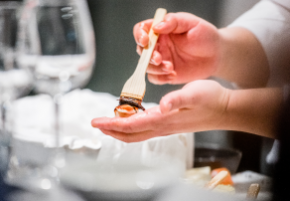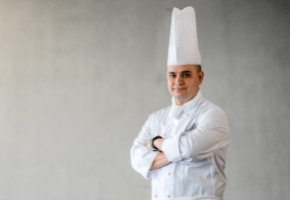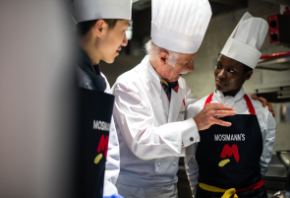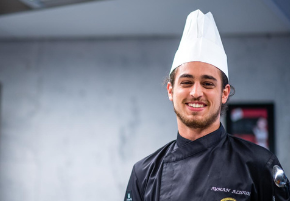- About
- Programs
- Campus Life
- Career Services
- Admissions
- News & Events
- Alumni
Famous Indian Diwali Food: 15 Dishes You Must Try
Explore the most famous Diwali food, from sweets like Ladoo to savory Samosas. Get inspired with 15 traditional dishes perfect for the festival of lights.
Key Takeaways
- Diwali cuisine is known for its incredible range of textures and flavors—crispy, creamy, spicy, and sweet.
- Some of the most popular Diwali foods include ladoo, gulab jamun, jalebi, barfi, samosas, chole bhature, and biryani.
- Every dish balances contrast and harmony, mirroring the festival's own mix of energy and warmth.
For generations, Diwali has marked a time when light triumphs over darkness and goodness restores balance. The festival is rooted in age-old traditions and represents a celebration of renewal and unity that brings families and communities together around shared rituals and warm gatherings.
The dates of Diwali shift each year because they follow the Hindu lunisolar calendar. The festival usually falls between mid-October and mid-November. This year (in 2025), Diwali will begin on Saturday, October 18, and end on Thursday, October 23.
As is the case with many other celebrations, food plays a big role. Diwali food is quite diverse, encompassing different dishes that represent generosity, gratitude, and the joy of sharing abundance with others.
Famous Indian Diwali Foods
Indian Diwali menus traditionally include three main categories: sweets (mithai), savory snacks (namkeen), and main courses. Each highlights a different aspect of Indian cooking—sugar work, frying precision, and spice layering. Below are fifteen dishes that often grace festive tables, along with short preparation notes to help guide your own kitchen practice.
Ladoo (Motichoor, Besan, Coconut)
Ladoo is one of the most iconic Diwali sweets. There are a few varieties, and each one offers a distinct texture and flavor.
Motichoor ladoo is delicate and grainy, besan ladoo has a smooth, nutty aroma from roasted gram flour, while coconut ladoo is soft, chewy, and fragrant with cardamom.
How to prepare:
- Motichoor: Fry tiny boondi droplets, soak in warm syrup, and shape into balls.
- Besan: Roast gram flour in ghee until fragrant, mix with syrup, and roll into spheres.
- Coconut: Toast coconut with condensed milk, mix in cardamom, and shape while warm.
Gulab Jamun
Gulab jamun is the definition of indulgence—soft, spongy, and soaked through with rose-scented syrup. The combination of milk solids and aromatic syrup makes each bite both rich and floral, perfectly balancing sweetness with delicacy. Often served warm and garnished with pistachios, it remains one of the most beloved Indian desserts.
How to prepare
- Combine khoya, flour, and a pinch of baking soda into a soft dough
- Roll into smooth, crack-free balls (if there are cracks, then there can be syrup absorption issues)
- Deep-fry on low-medium heat until golden-brown
- Transfer immediately to warm sugar syrup infused with rose water and cardamom
- Soak for at least 2 hours before serving
If the dough feels sticky, dust your hands with flour. However, make sure not to add excess flour to the dough itself, or the gulab jamun will become dense.
Kaju Katli
Kaju katli is a cashew-based fudge prized for its silky texture and clean sweetness. Its diamond shape and silver leaf finish make it a festive favorite often given as gifts during Diwali.
How to prepare
- Pulse cashews in a food processor until powdery (not paste)
- Cook sugar on a low flame until it reaches the one-string stage
- Fold cashew powder into the syrup off the heat, mix into a non-sticky dough
- Roll between parchment sheets to ¼-inch thickness
- Cut into diamonds, apply edible silver foil if desired
Overprocessing cashews releases oils and creates a paste. So it's best to stop before that point in order to maintain the fudge-like texture.
Jalebi
Crisp on the outside and syrupy within, jalebi is a visual and sensory delight. Its bright orange coils glisten with syrup, offering a tangy-sweet flavor and satisfying crunch that softens as you bite in. Fresh jalebi is best eaten within minutes of frying, when it still crackles lightly.
How to prepare
- Whisk flour, yogurt, and turmeric into a smooth batter; let ferment overnight
- Heat oil to 175°C (350°F )
- Pipe batter through a squeeze bottle or piping bag in spiral shapes
- Fry until crisp, drain briefly, and soak in warm syrup for 30 seconds
- Serve immediately, optionally paired with rabri (thickened sweet milk)
Rasgulla
Start Your Culinary Journey
Learn the art of cooking in a world-class environment
Rasgulla's airy texture and clean syrup make it a refreshing counterpoint to the richer sweets of Diwali. Originating from Bengal, it has become a pan-Indian staple.
How to prepare
- Curdle whole milk with lemon juice, drain, rinse under cold water
- Knead chenna on a flat surface for 8–10 minutes until smooth
- Roll into small, crack-free balls
- Boil in sugar-water syrup on medium heat for 15–20 minutes (balls will expand)
- Cool in syrup, refrigerate for at least 2 hours
Proper kneading is crucial for this recipe. Under-kneaded chenna produces dense, rubbery rasgullas, whereas over-kneaded chenna may release too much moisture and disintegrate during boiling.
Barfi (Milk, Pista, Chocolate varieties)
Barfi is a dense, milky fudge that takes on endless variations. The classic milk barfi is rich and simple, while pista barfi introduces the flavor of pistachios, and chocolate barfi gives a contemporary twist to a traditional base.
How to prepare
- Heat khoya and sugar in a heavy-bottomed pan, stirring constantly
- Add flavoring (cardamom, ground pistachios, or cocoa)
- Cook until mixture forms a cohesive mass (10–15 minutes)
- Transfer to a greased tray, flatten with a spatula
- Cool, cut into diamonds or squares
Payasam / Kheer
Silky, creamy, and gently flavored with saffron and cardamom, payasam (or kheer) combines the warmth of slow-simmered milk with the natural sweetness of rice or vermicelli.
How to prepare
- Rinse rice and soak for 15 minutes
- Bring milk to a boil, add rice, and reduce to low heat
- Stir frequently to prevent scorching
- Add sugar and saffron once the rice is soft
- Garnish with fried nuts and raisins before serving
Samosa
Golden and crisp, the samosa is a classic festival pastry filled with spiced potatoes and peas. Its flaky layers give way to a soft, flavorful filling, creating a perfect balance of flavor and texture.
How to prepare
- Knead stiff dough with flour, ghee, and water; rest 30 minutes
- Boil and mash potatoes, sauté with peas and spices
- Roll the dough into thin circles, cut them in half, and form cones
- Fill with potato mixture, seal edges with water-flour paste
- Deep-fry until golden and crisp
Chakli / Murukku
Chakli (or Murukku), a spiral-shaped snack, adds a savory crunch to the Diwali table. Lightly spiced, it pairs perfectly with tea or as a snack throughout the festivities.
How to prepare
- Mix flours, spices, melted butter, and water into a soft dough
- Load dough into a chakli press fitted with a spiral disc
- Extrude spirals directly into 350°F (175°C) oil
- Fry until golden, drain on paper towels
- Store in airtight containers for up to 3 weeks
You can adjust the heat by adding red chili powder or omitting it for a milder version suitable for children.
Mathri
Mathri are savory crackers known for their flaky, layered texture and gentle spice. Their crisp bite and buttery flavor make them a favorite with evening tea or alongside sweets for balance.
How to prepare
- Combine flour, semolina, ghee, and spices
- Knead into a firm dough with minimal water
- Roll into thick discs, prick with a fork to prevent puffing
- Fry on low flame until golden and crisp (8–10 minutes per batch)
Low-temperature frying is essential since high heat crisps the exterior but often tends to leave the center doughy.
Chivda / Namkeen Mix
Chivda is a festive trail mix that balances heat, salt, and a touch of sweetness. It's made for sharing during the Diwali festival—something to snack on as lamps are lit and stories are told.
How to prepare
- Heat oil, fry poha in batches until golden, set aside
- In the same oil, fry peanuts, cashews, and chana dal
- Temper with mustard seeds, curry leaves, turmeric, and chili powder
- Toss fried poha and nuts with the tempering
- Add sugar for a sweet-savory balance, cool completely before storing
Pakoras
Pakoras are the perfect snack for rainy evenings or festive gatherings. Their crisp golden shells are usually filled with soft vegetables or paneer inside.
How to prepare
- Mix gram flour, rice flour, spices, and water into a thick batter
- Slice vegetables thinly (onions, potatoes, spinach leaves)
- Dip vegetables in batter, shake off excess
- Fry in batches until golden and crisp
- Drain on paper towels, serve hot
Paneer Butter Masala
Paneer butter masala is one of India's most beloved curries. The smooth tomato-cashew sauce, buttery undertones, and tender paneer cubes make it a luxurious main dish for any festive spread.
How to prepare
- Blanch tomatoes, blend with soaked cashews into a smooth puree
- Heat butter, sauté the puree with ginger-garlic paste
- Add garam masala, kasuri methi, and cream
- Simmer for 10 minutes, fold in paneer cubes
- Garnish with fresh cream and coriander
Chole Bhature
Chole bhature is a North Indian celebration dish that combines chickpea curry with puffed fried bread. Its vibrant flavors and contrasting textures make it a Diwali brunch favorite.
How to prepare
For the chole, follow these steps:
- Soak chickpeas overnight, boil until tender
- Sauté onions, tomatoes, and spices into a thick masala
- Add chickpeas, simmer for 20 minutes
- Finish with amchur and garam masala
For the bhature, the recipe requires you to:
- Knead dough with flour, yogurt, baking powder, and ghee; rest 2 hours
- Roll into thick discs, fry in hot oil until they puff and turn golden
Biryani and Pulao
Biryani and pulao are, in many cases, considered the grand finale of any Diwali feast. Biryani is slow-cooked and layered, while pulao is a simpler one-pot meal, both delivering deeply aromatic comfort.
How to prepare
For the biryani, the recipe requires you to:
- Sauté vegetables with ginger-garlic, yogurt, and garam masala.
- Parboil basmati rice to about 70% doneness.
- Layer rice and vegetables in a heavy-bottomed pot and drizzle with saffron-infused milk.
- Seal the lid with dough and cook on low heat for 20 minutes (dum method).
- Garnish with fried onions, mint, and cilantro before serving.
To prepare pulao, follow these steps:
- Heat the ghee and sauté whole spices such as cinnamon, cloves, bay leaves, and cardamom.
- Add chopped onions, vegetables, and salt, then stir in rinsed basmati rice.
- Pour in water or vegetable stock in a 1:2 rice-to-liquid ratio.
- Cover and cook on low heat until the rice is tender and the liquid is absorbed.
- Fluff gently with a fork and serve with raita or pickle.
How to Plan a Diwali Main Course
Building a balanced Diwali menu requires incredible attention to flavor, texture, as well as inclusivity. It's best to first select the main dish, as that will help set the tone for the rest of the meal. From there, add complementary sides that contrast and balance one another.
Once you've chosen your centerpiece, perhaps a rich paneer butter masala or an aromatic biryani, you can begin building around it with supporting dishes that add contrast and balance.
A creamy curry pairs beautifully with a dry vegetable preparation such as aloo gobi or bhindi masala, while a lentil-based dish like dal tadka adds warmth and protein. To bring the meal into harmony, include a yogurt-based side such as raita or plain curd, which helps cool the palate and rounds out the range of flavors.
With the core dishes decided, it's easier to plan ahead. Advance preparation not only reduces stress but also ensures a smoother cooking process on the day of celebration. Gravy bases like tomato-onion or cashew paste can be made a day earlier and finished with cream just before serving. Snacks such as samosas or pakoras can be fried in the morning and reheated briefly in a 175°C (350°F) oven before guests arrive. Rice dishes like biryani or pulao are best cooked close to serving time so their aroma and texture remain fresh.
To complete the meal, add a variety of breads. Offering naan, roti, and puri gives guests choice and texture, creating a more satisfying dining experience. As you finalize your spread, consider dietary preferences so that everyone feels included. Many snacks are naturally vegan when fried in vegetable oil instead of ghee, and rice-based mains make excellent gluten-free options when paired with alternatives like millet roti.
Finally, presentation matters as much as flavor. Before serving, garnish each dish with fresh herbs, a drizzle of cream, or a pinch of saffron. Keep everything warm and arranged neatly in festive serving dishes. A well-planned Diwali meal should celebrate abundance but also reflect the care and hospitality that define the festival itself.
At Culinary Arts Academy Switzerland, students develop a refined understanding of timing, technique, and flavor balance—the kind of mastery that makes it possible to plan intricate Diwali meals. The academy's curriculum blends classic culinary foundations with modern kitchen management and creative menu development, helping students connect precision with personal expression.
This training deeply influenced Tanuvee Agarwal, founder of Atticus, a fine dining catering company in Delhi that brings together Swiss discipline and Indian tradition. She credits her time at CAAS for teaching her the organization and consistency required in professional kitchens.
Apart from acquiring the cooking skills which I use every day, one major thing I've picked up is how to organize workflows in a more systematic way,
she explained.
From managing staff to designing sustainable menus, Agarwal applies what she learned to build a catering business that reflects both technical excellence and cultural authenticity.
Festive Diwali Drinks
Beverages play a supporting role in Diwali feasts as they help cut through the richness of many of the dishes and refresh the palate. Some traditional drink options include masala chai (black tea steeped with cardamom, ginger, cloves, and milk) and lassi (yogurt blended with water, sugar or salt, and cardamom that is served sweet or salted based on preference).
Some other popular drink options include:
- Jal-Jeera: Cumin-spiced water with mint, tamarind, and black salt—a digestive aid after heavy meals
- Fresh juices: Pomegranate, orange, or watermelon juice served chilled
- Modern fusion: Cardamom-infused lemonade, saffron-rose mocktails, or iced chai lattes
It's best to match drink sweetness to food spice levels. If serving spicy chole bhature, offer cooling lassi or jal-jeera. For sweet-heavy spreads, serve unsweetened masala chai or sparkling water with lime to cleanse the palate.
Bringing Diwali Flavors to Your Kitchen
Every dish on this list bursts with flavor and celebration. From syrup-soaked sweets to aromatic rice dishes, these recipes capture everything that makes Diwali special.
But mastering such dishes takes more than following a recipe. It's about understanding how heat transforms texture, how flavors build harmony, and how contrasts can help turn a meal into an experience. These are dishes that can brighten any day of the year, offering a taste of Diwali's radiance in every bite.
For those who want to refine this understanding in a professional setting, Culinary Arts Academy offers programs designed to transform passion into mastery. The Bachelor of Arts in Culinary Arts and the Swiss Diploma in Culinary Arts go far beyond basic cooking. Students learn everything from knife techniques and plating precision to the art of balancing global flavor systems. Everything is taught in world-class facilities guided by industry professionals.
With a community representing over 60 nationalities and an international faculty of chefs, the academy gives students a rich exchange of culinary perspectives. Our Distinguished Chef Series brings visiting chefs from around the world for hands-on master classes. This October, Michelin-starred Chef Deepanker Khosla will lead a session on his Euro-Indian fusion cuisine, offering students insight into how tradition and innovation can meet on the plate.
Cooking, like Diwali, is about sharing abundance and creating connections. By learning how to perfect your craft with us, you continue that same spirit—bringing light and artistry to every meal you prepare.
Frequently Asked Questions
What are some traditional snacks people from different countries eat on Diwali?
While Diwali is primarily an Indian festival, diaspora communities worldwide have adapted it to incorporate local ingredients. UK celebrations may feature fusion samosas with British cheeses, while US hosts might serve pakoras alongside ranch dip.
What are some healthy snacks to try during Diwali?
Opt for baked mathri instead of fried, air-fried pakoras, or roasted chivda with minimal oil. Such snacks retain flavor while reducing fat content.
Can traditional Diwali sweets be made sugar-free?
Yes, you can use sugar substitutes like stevia or erythritol in recipes like ladoo or barfi, though the texture may differ slightly.
Interested in becoming a world-class chef? Learn more about Culinary Arts Academy Switzerland. Download our brochure.

























